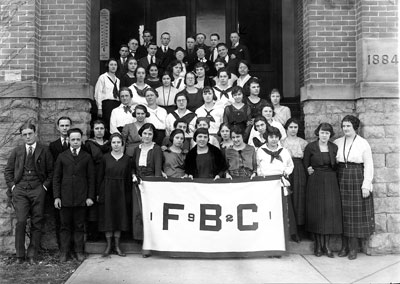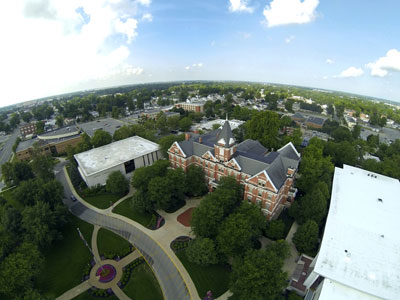The first graduating class of Findlay College, one man and one woman, received their diplomas in June 1889, just three years after beginning their studies in Old Main. Their graduation represented the culminating step of a process that started in 1881 when the Churches of God, General Conference, conceived of establishing a college in northwest Ohio. Co-founded in 1882 by the church and the citizens of the City of Findlay, Findlay College incorporated as an educational institution and the first classes began in 1886. Instruction began in the height of a natural gas and oil boom that made the City of Findlay one of the most prosperous and exciting communities in the country. That heritage is noted today in the name of our athletic teams: the Oilers.
Underfunded from the beginning and recovering from debt, financial problems, and economic difficulties fueled by the national economy, the first three presidents of the institution, Rev. John Lathchaw, Rev. William Yates, and Rev. Charles Fox worked to ensure the survival of Findlay College throughout the turn of the century. With continued fundraising efforts, the endowment reached $277,000 by 1925. Increased financial support also allowed for the construction of a new gymnasium in 1925 and the Griffith Memorial Arch in 1923. The arch later became the site of the traditional Arch Ceremony where all graduates of Findlay walk at graduation.

In the 1920s and 30s, the growing importance of the standardization of higher education made accreditation a priority for College presidents and administrators. With the hiring of additional faculty, particularly those with doctoral degrees, and steady increases to the endowment, Findlay College first achieved state accreditation from the Ohio College Association in 1931 and the North Central Association in 1933. During the Depression, sacrifices were made to salaries, departments, and maintenance, and enrollment was maintained, only to drop to a low of 132 students during World War II. Though rebounding to 474 in 1946-47, the NCA rescinded accreditation in 1948, with low endowment and faculty salaries and insufficient dormitories and library holdings among the named deficiencies.
The effort to retain accreditation status stimulated campus expansion including additional dormitories for men and women as well as renovations and an extension to Old Main in 1956 and later the construction of the Alumni Memorial Union and Brewer Science Hall in 1961. The number of faculty with doctoral degrees increased, the curriculum was revised and the administration reorganized. Based on the accrediting body's objections, President Ollie Wilson also convinced the board and the church to limit the authority of the church over the board of trustees. The Winebrenner Graduate School of Divinity that had been established in 1942 separated from Findlay College in 1961 and became Winebrenner Theological Seminary. Financial operations were further stabilized and when Findlay submitted its self-survey in 1961, the College was added to the list of accredited institutions on a limited basis.
Building growth continued with the completion of the Egner Fine Arts Center in 1964, and Morey and Fox residence halls. Enrollment began to break records each year, increasing to 545 students in 1959 and 980 by the fall of 1962. Shafer Library was completed in 1968, and President Frick and his wife led 53 faculty and 460 students in a book moving project which took an estimated 55,000 volumes from the library in Old Main to the new building. In 1969, the NCA granted a continuation of accreditation and scheduled the next review in 10 years, a significant accomplishment in the process started more than 20 years prior. The building boom continued with the construction of Croy Gymnasium, Sink Natatorium and Deming, Henderson and Bare halls, marking a time of growth and change for the College..jpg)
Enrollment fluctuated in the late 60s and 70s from 1,456 students in 1967-68 to 892 in 1976, and then began making steady increases reaching 1,208 in 1981. The enrollment increase and support of multiple fundraising campaigns led to budget surpluses in the late 70s and early 80s. The College's academic programs expanded to include, among others, public administration, nuclear medicine technology, computer science, pre-veterinary medicine, the western equestrian studies program, freshman seminars and the first class of international students in the Intensive English Language Institute in 1975. All of these strengthened the educational experiences offered by the College and successfully attracted more students as it advanced into its second century in 1982.

Growth in academic programs and also the campus were hallmarks of next 20 years, including the introduction of more than 14 career-oriented programs from bilingual business education to physical therapy and the addition of master's programs. In 1989, the addition of graduate programs, enrollment growth and the need to continue to strengthen the institution for the future led to a name change from Findlay College to the University of Findlay. Enrollment tripled from 1983 to 1993, reaching 3,375 full-and-part-time students in 1993-94, and the endowment tripled as well, reaching $9.6 million in 1993. The increase in enrollment and programs led to renovation needs and the construction of special facilities including the Phil Gardner Fitness Center, the Kenneth Frost Science Center, the James L. Child Jr. Equestrian Complex, and the Virginia B. Gardner Fine Arts Pavilion. From 2005 to 2010, the hiring of more than 40 more full-time faculty members emphasized the importance of a supportive atmosphere, student engagement and high-quality interaction between faculty and students.
The pace of advancement has never diminished. Today, the University of Findlay continues to deliver on the promise of academic excellence, transformative experiences, and a supportive community. Every student can take advantage of experiential learning opportunities beyond the classroom. Just as the first two graduates of Findlay College were prepared for their futures, today's graduates walk through the arch prepared to lead meaningful lives and productive careers.
Historical information on these pages from prior to 1982 comes from Findlay College: The First Hundred Years by G. Richard Kern, Ph.D., professor emeritus of history. More recent information was gathered and compiled by Charlene Hankinson M'09, retired staff member, and current Marketing and Communication staff of the University of Findlay.